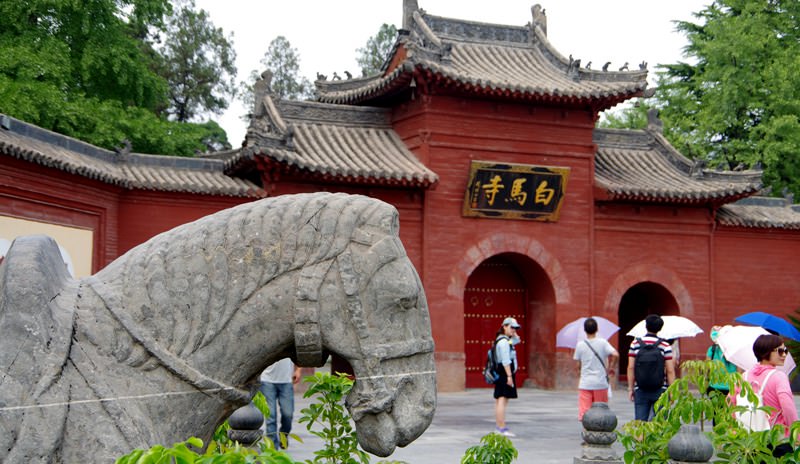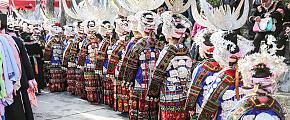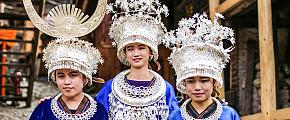Chinese Buddhism
Buddhism first reached China from India around the Christian era, some 2000 years ago. Over a long period’s transmission and development, it has possessed Chinese features. Chinese Buddhism can be classified into Han Chinese Buddhism, Tibetan Buddhism and Theravada Buddhism (Southern Buddhism). Han Chinese Buddhism and Tibetan Buddhism belong to Mahayana Buddhism and Theravada Buddhism belongs to Hinayana Buddhism.
 Chinese Buddhism
Chinese Buddhism
Han Buddhism
Buddhism is believed to have been introduced during the Eastern Han Dynasty (25-220 AD). Chang'an and Luoyang became the centers of Chinese Buddhism at that time. The first Buddhist temple in China was built East of Luoyang city. It was named the White Horse Temple. According to legend, the Buddhist scriptures were carried to Luoyang by a white horse, hence the name. The scriptures that were used in the Eastern Han Dynasty were translated into Chinese in this famous temple.
As more and more Buddhist Sutras were being translated into Chinese during the Three Kingdoms (220-265), Wei (220-264), and the Western Jin Dynasties, Buddhism grew rapidly. Luoyang, the capital city of the Wei Kingdom, and Jianye (today's Nanjing) the capital city of the Wu kingdom were the Buddhist centers at that time. During Eastern Jin (317-419 AD) and the North and South (317-589) dynasties, Buddhism had become extremely popular, and many Buddhist towers, pagodas, and temples were being built. It was during this time that the famous Buddhist rock grottos were being created. The most famous Buddhist grottos in China are the Dunhuang Grotto, Yungang Grotto and Longmen Grotto. They are renowned for their Buddhist art and carving. The most renowned contributors to Buddhism at that were Jiumoshi and Faxian. Jiumoshi was a great Buddhism Sutra translator, and Faxian was a Buddhist who traveled to over 30 countries in Southern Asia, such as ancient India and Sri Lanka… and brought back a great number of scriptures and materials on each location's Buddhist traditions.
Buddhism flourished in the Sui (581-617 AD) and Tang (618-907 AD) Dynasties. During this period, many classic scriptures were translated into Chinese and Buddhism, and Buddhists and temples were under the government's protection. Some of the most famous Buddhist buildings were also being built at this time, for example; the Big Wild Goose Pagoda and the Small Wild Goose Pagoda in Xi'an.
 Chinese Buddhism
Chinese Buddhism
Tibetan Buddhism
Tibetan Buddhism is commonly known as Lamaism. Lama means 'great master' in the Tibetan language. It began in the mid-7th century, at the time when Sontzen Gampo, the king of Tibet married the princesses of Nepal and the Tang Dynasty. Both two brought the figures of Buddha and the Buddhist scriptures to Tibet. Under the influence of the princesses, Sontzen Gampo converted to Buddhism and had the Jokhang Temple and the Ramoche Temple built. In the mid-8th century, Buddhism was directly imported from India to Tibet, and in the second half of the 10th century, Tibetan Buddhism was formally formed. Tibetan Buddhism began to spread to the Mongolia region in the 13th century. After more than 300 years, different schools of Tibetan Buddhism began to form. With the development of Buddhism in Tibet, the upper lamas eventually controlled the local government, and Tibetan Buddhism was united with politics. If you take a Tibet tour, you'll find Tibetan Buddhism is the collective belief of Tibetan people.
Famous Tibetan Buddhism Architecture
Jokhang Temple, Ramoche Temple, and the Potala Palace are the three most famous centers of Tibetan Buddhism. The most famous example of Buddhist architecture is the Potala Palace. It was originally built as the Tang Dynasty princess' palace when she reached Tibet in the 7th century, but it did not reach its present scale until the 17th century.
Southern Buddhism
Southern Buddhism located in Yunnan Dai, Bulang, and other areas shares the same belief system as traditional Buddhist countries in South Asia (Thailand, Myanmar, etc.). This Buddhist school was introduced into the Yunnan Dai area in the mid-17th century. For many centuries, the local Buddhists have maintained the original Buddhist Dharma, discipline and study.
Famous Southern Buddhism Architecture - The Three Pagodas of Chongsheng Temple
The Three Pagodas of Chongsheng Temple are the most famous pagodas in the Southern Buddhism style. It combines the architectural styles of Dai and the Bai ethnic minority groups. They were built between 826-839 AD and were greatly influenced by Tang Dynasty pagodas. They stand high and grand and are located only 1.5 km away from the Dali Ancient City.
See the TOP10 China Tours or start tailor-making your own with us.
Quick Question
What Our Clients Say
SUBSCRIBE TO WIN A FREE TOUR
Subscribe to our newsletter for a chance to win a free 7-day Morocco tour! And more insider travel news, exclusive offers, and inspiration will be sent straight to your inbox.







